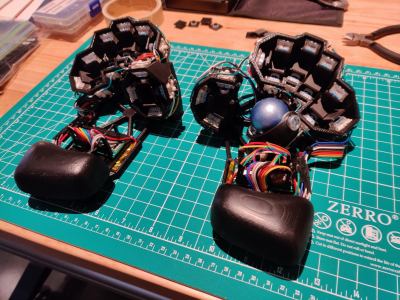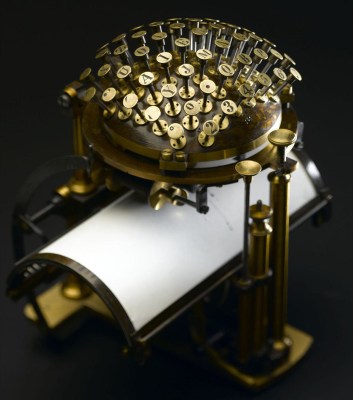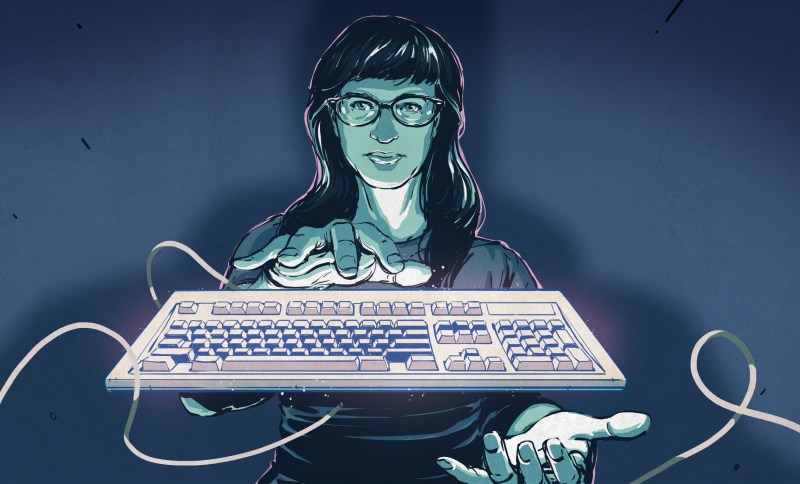I keep saying I need to stay away from auction sites, but then I wouldn’t have as much fodder for Hackaday, would I? As I write this, I’m waiting on a Dell AT101W, which will be my first keeb with Alps switches. Well, hopefully it has Alps SKCM salmon or black switches — according to Deskthority, it might have rubber domes. If it doesn’t keyboard, I will probably salvage the switches and build something more ergonomic. Either way, I’m thinking we need a post about Alps switches, because some people think they’re even better than Cherry MX switches.
Make Mine Maltron
Speaking of loyal Cherry MX enthusiasts, Maltrons are arguably the grandaddy of ergonomic keyboards, and the UK company that produce them have been around since the 1970s. Not only were they the first to use concave key wells, Maltron adapted their design and made some of the first one-handed and mouth-driven keyboards as well. They even have keyboards with built-in trackballs.

A two-handed, curved Maltron is definitely on my short list of holy grail contenders. Each one of these keyboards is painstakingly wired by hand, so they’re pretty expensive — even the ones that are already Stateside. $700 is hard to swallow for a keyboard that I might not like any more than the Kinesis Advantage that it inspired.
But the good news is that Maltron offers a DIY kit that’s customizable! They are selling everything a la carte from the injection-molded shell to the Teensy 2.0 to the key caps, which come with either lasered-on legends or no legends at all. We don’t see anything about an instruction manual, so you’re on your own as far as wiring it up.
If all I wanted was the shell and the trackball unit, that’s only £120 plus shipping and VAT. But unless I can find a kit distributor in the States, the shipping charges of these two pieces alone might cloud the allure of building one myself. I’ll have to mull it over and get a shipping quote.
One-Handed Keyboards Can Be DIY, Too

We’re not sure if one-armed writer [Britt H. Young] has ever tried a Maltron, but her quest for the perfect mechanical keyboard is a good read either way.
[Britt] begins by recalling the federal safety-orange keyboard skin with the one-handed Dvorak layout that brought so much negative attention in elementary school typing class, so perhaps the one-handed Maltron is too clinical a solution. Between the curved key well and the ortholinear layout, it’s a lot to adapt to. Bad memories aside, [Britt] has always been fond of loud keyboards and longed to clack like back in the day.
Fortunately it’s 2021, and there are a ton of options out there for building your own keyboard. Some keycap profiles do not play nicely with the key swapping that [Britt] requires, but DSAs do. For that very reason, [Britt] settled on a Tofu65 board with Kailh whites and these beautiful DSA keycaps shown here. Happy clacking, [Britt]!
Hands-on Hacking: the Grabbity Gloves

Believe it or not, this is [loopsbellart]’s first build, and they’re already playing around with what-ifs. What if every key was on the home row, or at least as close to it as possible? That’s the idea behind the Grabbity Gloves.
This cyberpunk beauty reminds us of the lalboard, the DataHand keyboard that inspired it, and the equally minimalist Squeezebox. But in this case, the fingers only push and pull and don’t also press down. We’re not sure, but that might be for the better. We’ll just have to build one and find out for ourselves, taking [loopsbellart]’s lead to put lighter springs in at least the forward-actuated switches.
The Grabbity Gloves are completely wireless thanks to a pair of nRF52840s. Their main brain is a BlueMacro840 running BlueMicro firmware, but the ‘840 is pin-compatible with the Arduino Pro Micro if you want to run QMK instead. Although [loopsbellart] isn’t planning to sell these, they are willing to release the STL files. Here’s a gif of the Grabbity Gloves in action.
Historical Clackers: the Malling-Hansen Writing Ball

Long before the idea of concave key arrangements came along, there was this convex typewriter that looks like a pin cushion or a dull porcupine. The type bars (if you can call them that) strike at a right angle to the orientation of the keyboard. That’s right, it types sideways, and early models blocked the user’s view of the results. The paper advances in a gentle arc via electromagnet as you fill up the page. Later versions used a mechanical escapement.
The Malling-Hansen Writing Ball was the first commercially-sold typewriter, beating Scholes & Glidden’s Remington I (featuring the QWERTY layout) to market by a few years. The Ball was invented by the reverend Rasmus Hans Malling Johan Hansen, a teacher and director at an institute for the deaf and mute in Copenhagen.
Hansen wanted his students to be able to speak with their fingers, and thus created the Ball to be easy to use quickly. Some other types were made, including a model for telegraphs, one for cryptographers, and one for the blind. Only 200 or so of these were produced, and about 40 are still around today.
Nietzsche Was on the Ball
“the Writing Ball is a thing like me: made of iron, yet easily twisted on journeys.
Patience and tact are required in abundance, as well as fine fingers to use us.”
Friedrich Nietzsche
When Friedrich Nietzsche’s eyesight began to fail, writing the normal way would give him terrible headaches. According to letters written to his sister, Nietzsche was in direct contact with Rasmus Hansen and had the latest and greatest version of the Writing Ball sent to him in 1882.
Unfortunately, sources suggest that he couldn’t use it because it was damaged in transit, and the repairman he took it to only damaged it further. He must have had it repaired or replaced at some point, because he was enamored by it enough to write a poem about the thing.
If you want to watch one of these clack, you’re in luck. One [Felix Herbst] modeled the Writing Ball and made an animation that shows it in action, which you can see below. [Felix] also made an interactive version that lets you type letters in the original font and send or print them, but it seems to be broken.
ICYMI: This Old Mouse
 Yes, I know — this is Keebin’ and not Mousin’, but the input-related hacks have been mouse-heavy since the last one of these. And besides, the buttons on this old Depraz mouse look clicky and inviting and a little bit like Kailh chocs.
Yes, I know — this is Keebin’ and not Mousin’, but the input-related hacks have been mouse-heavy since the last one of these. And besides, the buttons on this old Depraz mouse look clicky and inviting and a little bit like Kailh chocs.
Now that [John Floren] has built a USB adapter for this lovely mouse using an Arduino Pro Micro, he reports a pleasant hand-feel and a satisfying clickiness to the buttons. You can hear them toward the end of the short demo video.
Got a hot tip that has like, anything to do with keyboards? Help me out by sending in a link or two. Don’t want all the Hackaday scribes to see it? Feel free to email me directly.

















I have a serious concern about how a concave “key well” could alleviate RSI.
To me, it would make it much worse…
I’ve been using a Kinesis Advantage (it has key wells) for about a year and a half now, and it has helped me immensely. YMMV!
Now that I have been to the Maltron website, I see the keyboard that made me shudder is for a disabled person to push the keys with a stick in their mouth.
As Foghorn Leghorn used to say; “I say, I say Boy, you got it all WRONG!”
The idea is that it should eliminate much of the extension and contraction your fingers must do to move between the rows of the keyboard, essentially each of the rows should be closer to your fingers when your fingers are at ‘idle’ on the home row.
“Patience and tact are required in abundance, as well as fine fingers to use us.”
Friedrich Nietzsche”
to use US?
Maybe it’s a German thing….
(smacking head)
Doh! The poem was about him and the machine!
I was fortunate enough to pick up both a really old Kinesis as well as a Dell AT101W (in black) in a single trip to my local university surplus. Haven’t used the Kinesis much because its mx browns were kind of “sticky” and not smoothly sliding – just got around to cleaning it due to an injury – but I did use the Dell as my main daily keyboard for probably 5 out of the last 8 years. Its worst feature is the very large footprint: not only is it full size, but it has huge margins too.
Actually was using it until I got a funky compact-width (server rack sized) Cherry G80 (-11800 iirc?) with Compaq branding and built in trackball in the last year or two, which gives me some of the 60% benefits without denying me my numeric keypad, arrow keys, or cursor control keys: it just puts them in weird places.
I’ve got some old Apple keyboard with mechanical switches (Alps) that I’m kind of tempted to hack sometime…
I picked up several AT101W’s out of the garbage pile when I worked for the IT dept at my local university, back in ’08.
I’m still using one as my daily driver, black Alps switches yeah. I like it but I’ll admit I’m complete noob in the keeb domain. I’m on the lookout for a split keeb to build that I could install Alps switches in.
Please advise when you start doing this!
The lexmark made Dell AT101W’s are good, but Dell used this model name haphazardly on several other keyboards that aren’t mechanical. Even non-working ones aren’t necessarily a bad buy, the cables connect with large contacts, and the main i/o chip is high on the top side of the board so even shorted boards are usually repairable when disassembled.
The downside is that compared to more modern keyboards, those black alps switches have higher actuation force when new, and it generally goes up with wear.
Also using an AT101W as a daily driver. Picked it up out of the discard pile at work. I have it going through an ATtoUSB adapter, as a peripheral to my (closed) work laptop. My other kb is a Model M, on my home system. It’s a bit nocer to use, but the Dell is fine. Way better than the new, flat designs and we won’t even mention the laptop keyboards, which I will not use unless forced.
I love my classic keyboards.
Not to be a naysayer, but that “gif” of the grabbity gloves doesn’t actually show the person typing anything. They move their fingers around in there for a while, then move the camera to something “typed” on the screen, but who knows when it was actually typed. Also, imgur doesn’t really have “gifs” anymore. Those are mp4s.
Dude.. really? I got news for you, I can set up any number of “macros” with a predetermined sentence that “types” the next letter in sequence on *ANY* keypress… and I would do it JUST to mess with you. I could also completely remap my keyboard, replacing the familiar keyboard layout with something completely different with no labels and what you “see”” me typing would have no correspondence with what is appearing on the screen, even if the screen is in frame with the keyboard. Furthermore, I could have a completely dead keyboard that is not connected to anything and have a second typist “off screen” doing the actual typing in synchronicity with my movements… All of those scenarios are entirely possible using standard “off the shelf” keyboards and Windows remapping and you would never know the difference… so the resulting question becomes, why do you have to be so negative and disbelieving when there is no real motivation for profit or misdirection from the inventor? By your own logic, your entire life could be a “Truman show” or “plugged into the Matrix”…. so I guess it is your own choice of how paranoid you are… Either way, I am more likely to believe a reasonable action or set of actions at face value if there is no apparent motivation for deception or subterfuge.
Later bet than never but i gotta stop scolling to dogpile on the AT101 love. I had the non-working of my backup pair open yesterday on the thought i’d have to scav the switches for a project. I ended up finding the baggie of Alpses i’d removed from an Apple keyboard ages ago but in the meantime quick cleaning had returned at least one of the stuck keys to function. Ah, technology that’s designed to work!